Add organization-wide email disclaimer or html signature with embedded images in Exchange Server 2007/2010/2013/2016/2019 - Tutorial¶
An email disclaimer, legal disclaimer, disclosure statement, signature, or other information can be added to the top or bottom of email messages that enter or leave your organization in Exchange Server. You might be required to do this for legal, business, or regulatory requirements, to identify potentially unsafe email messages, or for other reasons that are unique to your organization.
Note
You can create the disclaimer in Exchange Admin Center -> Mail flow -> Rules -> Choose Apply disclaimer.
Here is a tutorial: Enable server-side email signature in Exchange server by transport rule
However, there are some limitations in Exchange built-in disclaimer:
- Insert the signature directly under the latest email reply or forward.
- No html editor available, you have to edit html codes manually.
- Image is not embedded to email, by default, most email clients won’t display the linked images.
- Skip lines which contain variables that couldn’t be updated (for example, if the value wasn’t provided for a user).
If you want to create your html signature or disclaimer with embedded image easily, you can use this custom disclaimer plugin in your Exchange Server.
This tutorial gives you a quick overview of how to add server-side disclaimer or html signature with embedded images to emails in Exchange Server based on customized rules.
Note
Organization-wide signatures are called “disclaimers,” regardless of what they include. For example, they can just be a signature, or also include your address, legal disclaimer, or other information you want.
Sections:
- How Disclaimer Plugin works?
- Install Disclaimer Plugin in Exchange Server 2007/2010/2013/2016/2019
- Create a simple server-side disclaimer/signature rule
- Sender group, recipient and subject conditions
- HTML disclaimer/html signature editor
- Use ADSI variables in dynamic email html disclaimer/signature
- Insert embedded image in email html disclaimer/html signature
- Use html disclaimer/html signature templates
- Insert or append disclaimer/signature intelligently
- Multiple disclaimer rules
- Header Conditions and Exchange Server Transport Rule
- Disclaimer Plugin troubleshooting
- Appendix: Digital signature and email encryption
- Free Email Support
How Disclaimer Plugin works?¶
In Exchange Server 2007/2010/2013/2016/2019, Disclaimer Plugin works as a transport agent, it can append/insert disclaimer or signature to email body based on specific rules.
A disclaimer/signature rule can be set for specified sender, domain, group, recipient or email subject.

Install Disclaimer Plugin in Exchange Server 2007/2010/2013/2016/2019¶
To enable Disclaimer Plugin in Exchange 2007/2010/2013/2016/2019, download EA Disclaimer and S/MIME Installer and install it on your server.
Note
Exchange Server Role
If you installed Exchange Server 2007/2010/2013/2016/2019 on multiple servers, you need to install this plugin on every Exchange Hub Transport Server Role.
Double click the installer file and the installation will be executed automatically. The installer requires Exchange server to be installed. If no Exchange server detected in your operation system, Setup will be aborted.
After the installation is completed, click “Disclaimer and S/MIME Manager” from “Windows Start menu” -> “All Programs” -> “EA Disclaimer and SMIME for IIS and Exchange Server” to begin the setup.
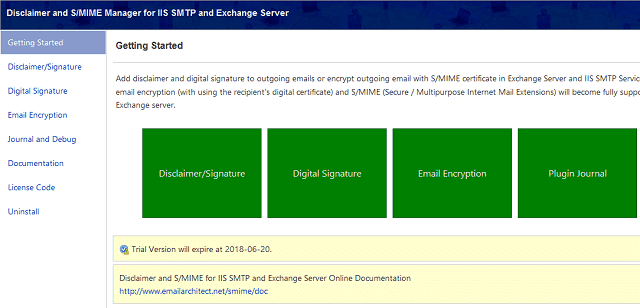
Important
After the installation is completed, you must check “Microsoft Exchange Transport Service”
and “Microsoft Exchange Mail Submission Service” in Control Panel -> Administrative Tools -> Services,
if these services are not running, start them.
Create a simple server-side disclaimer/signature rule¶
You can create a test server-side disclaimer/signature rule for a user like this:
- Click
Disclaimer/Signature->New, - Input any description for current rule,
- Input user email address in
Sender Address, - Click
Edit disclaimer/signatureto open html disclaimer/signature editor, input some text, clickOK, - Finally, click
Saveto save current rule.
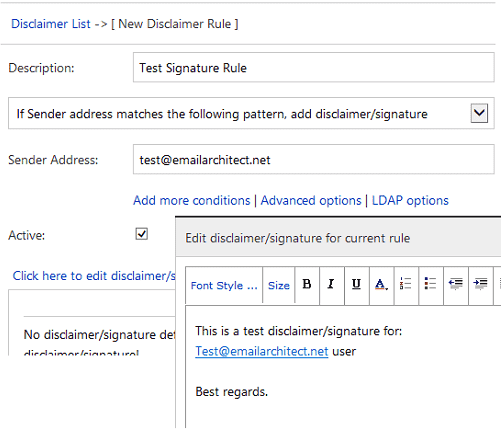
After rule is saved, click Test, current rule will be executed with a virtual email message, you can find the result in test dialog box.
If Test all rules is checked, all rules defined on current machine will be executed with a virtual email message.
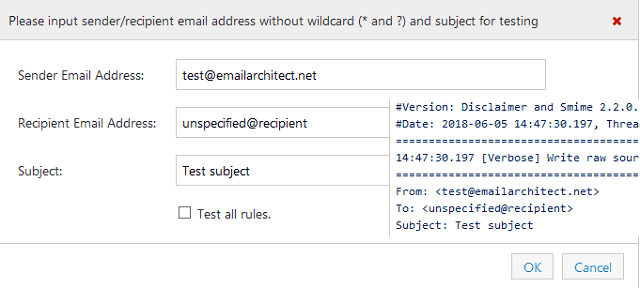
If test result looks good, you can send a test email from that user, and check if received email body has disclaimer/signature appended.
Sender address pattern and wildcard¶
A single email address or email address with wildcard (* and ?) can be used in Sender Address. It indicates current rule is only enabled for matched sender address.
Here are some examples:
If Sender address matches the following pattern, add disclaimer/signature
test@emailarchitect.net
# This rule is enabled for all emails from test@emailarchitect.net
If Sender address matches the following pattern, add disclaimer/signature
*@emailarchitect.net
# This rule is enabled for all emails from *@emailarchitect.net
If Sender address does not match the following patter, add disclaimer/signature
test@emailarchitect.net
# This rule is enabled for all emails except test@emailarchitect.net
If Sender address does not match the following pattern, add disclaimer/signature
*@emailarchitect.net
# This rule is enabled for all emails except *@emailarchitect.net.
Note
With wildcard (* and ?), you can define a rule for all users at domain level. Dynamic disclaimer/signature can be generated for individual users with ADSI variables and domain level rule.
To learn more details, please refer to Use ADSI variables in dynamic email html disclaimer/signature section.
Sender group, recipient and subject conditions¶
Besides sender address pattern, you can set additional conditions for sender group, recipient and email subject.
For example, click Add more conditions and change sender condition like this:
If Sender is from user in organization:
Above condition means current rule is just enabled for internal users, you can use ADSI variables in disclaimer.
If Sender is not from user in organization:
Above condition means current rule is just enabled for external sender, you may add some caution information in disclaimer.
If Sender is in one of group:
IT
Sales
Above condition means current rule is just enabled for sender that is in “IT” or “Sales” user group.
Note
In both Recipient Conditions and Subject Conditions, wildcard (* and ?) is supported.
HTML disclaimer/html signature editor¶

You can use html disclaimer or html signature editor to change font style, size, color and etc. Moreover, it provides two advanced functions:
Use ADSI variables in dynamic email html disclaimer/signature¶
ADSI Variables is used to personalize dynamic disclaimer or signature by utilizing user’s Active Directory objects attribute.
To add an attribute, use this syntax: {$adsi:AttributeName}, where “AttributeName” is the attribute you want to include in the disclaimer.
Build dynamic signature with variables¶
To learn how to use variables, let’s create a rule is like this:
If Sender address matches the following pattern, add disclaimer/signature
*@emailarchitect.net
The above rule is enabled for all emails from *@emailarchitect.net,
then include some ADSI variables in the disclaimer/signature like this:
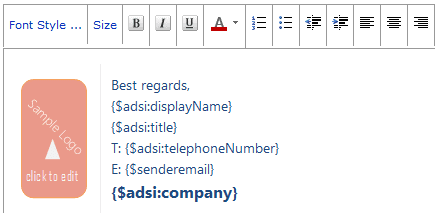
The following illustrates what email recipient see - all ADSI variables were replaced by the actual value in Active Directory User Attributes.
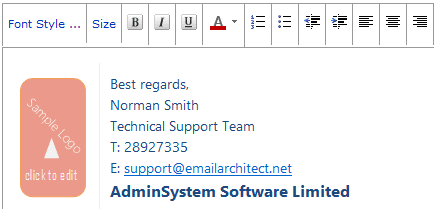
From the above example, you can see one rule can generate dynamic disclaimer/signature for individual user at domain level.
How to set active directory user attributes¶
Go to Administrative Tools -> Active Directory Users and Computers -> Users,
then select the user account you want to edit, right click -> Properties and edit it.
In Exchange 2010 or later version, user can edit his contact information via Exchange Server Web Access -> Options -> Account Information.

How to get attribute name¶
ADSI variable syntax is: {$adsi:AttributeName}.
Please note “AttributeName” is not the same as what you see in Active Directory User properties.
You need to use “ADSIEdit” tool to find out the real “AttributeName”.
Open “ADSIEdit” by Administrative Tools -> ADSI Edit, then right click -> Connect To and Click OK by default setting,
go to CN-Users node, and select one of Exchange User -> right click -> Properties.
You will see the real “AttributeName” in the first column of the following dialog:
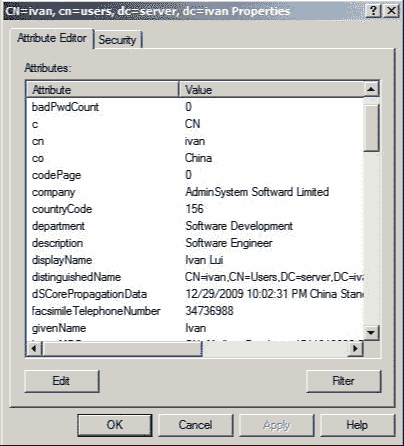
Common ADSI variables¶
In disclaimer editor -> “Insert ADSI variable”, it lists most common active directory user attributes. You can click the attribute name to insert it into editor current position.

Skip lines which contain variables that couldn’t be updated¶
If the variable value wasn’t provided for a user, you can put the variable in an individual line, the line will be skipped automatically.
// for example, if your signature is like this:
{$adsi:displayName}
{$adsi:title}
{$adsi:company}
// and if title is not provided for the user, the signature will become
displayName
company
Or you can use {$adsi:AttributeName?alternativeValue} to set an alternative value for non-existed variable.
// for example, if your signature is like this:
{$adsi:displayName}
{$adsi:title?Engineer}
{$adsi:company}
// and if title is not provided for the user, the signature will become
displayName
Engineer
company
Or you can use {$^prefix $adsi:AttributeName} to skip non-existed variable and its prefix.
// for example, if your signature is like this:
{$adsi:displayName}
{$^Phone: $adsi:mobile}
{$adsi:company}
// if mobile is provided, the signature will become
displayName
Phone: 123123899
company
// and if mobile is not provided for the user, the signature will become
displayName
company
Remote ADSI LDAP options¶
Disclaimer Plugin queries/replaces variables from current Active Directory by default.
However, if you want to query/replace ADSI variables from a Cross Forest Domain Controller or Remote Machine,
you can specify the LDAP server address, user name and password of that server in LDAP options.
Insert embedded image in email html disclaimer/html signature¶
Although a remote logo/image can be used in html disclaimer/signature, by default, the image won’t be displayed due to email client security policy.
To fix it, you can add logo/image by clicking Insert image, those images will be attached as embedded attachment in an email.
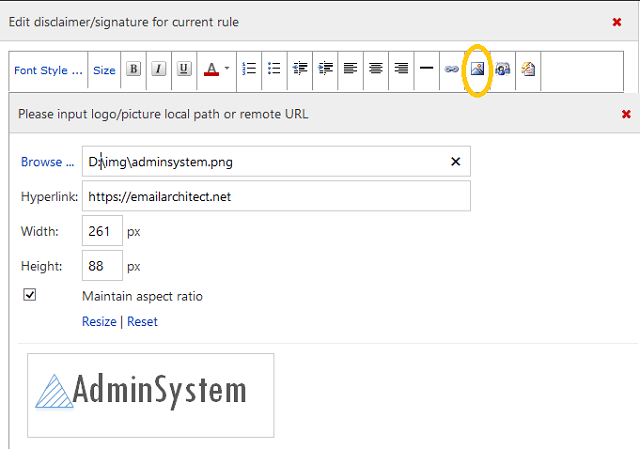
Embedded image is always displayed in email client by default. After you inserted the image, you can right click the image to edit again.
Image location and permission¶
IIS SMTP Service is running as Local System user, and Exchange Transport Agent is running as Network Service user,
so do not put the image file to Desktop or user-dependent folder,
Disclaimer Plugin doesn’t have permission to read image files in these locations.
Download remote image/picture as embedded attachment¶
If there are some remote images in disclaimer/signature content,
the editor will prompt “Do you want to download remote image as embedded attachment?” after OK is clicked.
You can click Yes to download all remote images as embedded attachments.
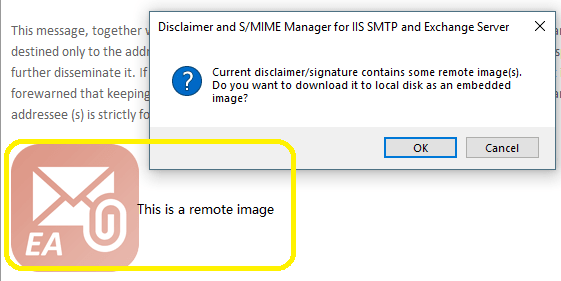
Use html disclaimer/html signature templates¶
In disclaimer/signature editor, two Signature Layout Templates,
two Confidentiality Notice, one Outside Caution and one Social Network are provided.
Signature Layout Templatesis used for personal signature;Confidentiality Noticeis used for organization-wide disclaimer;Outside Cautionis used for email from outside of the organization;Social Networkis used to insert social icons;
You can click Insert content from templates from the toolbar, select a template,
edit/remove variables, images, click Insert, template content will be inserted into editor.
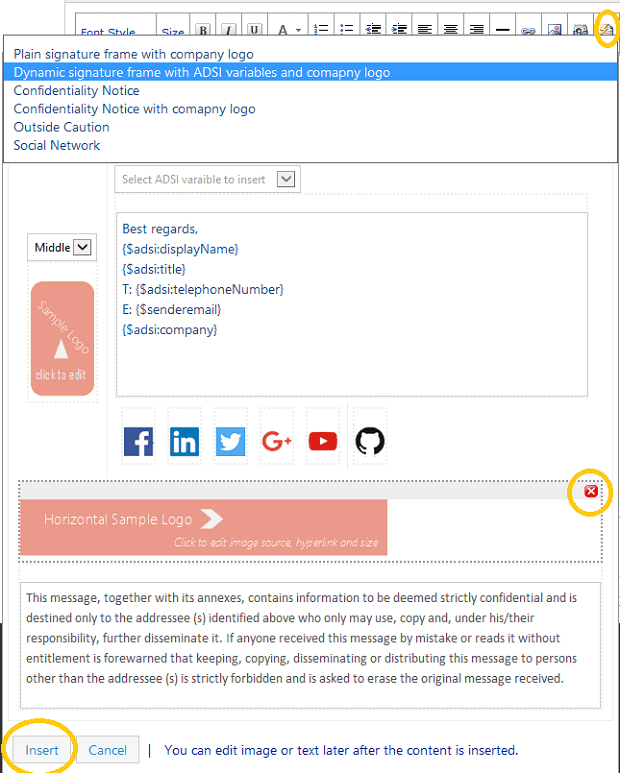
Note
After template content was inserted, you can still edit font style, size, color and etc. You can also click image to adjust the display size.
Insert or append disclaimer/signature intelligently¶
This is a default option to specify disclaimer/signature position in email body.
It appends disclaimer/signature to the end of email body in new email. On the other hand, it inserts disclaimer/signature before original body content in replied/forwarded email.
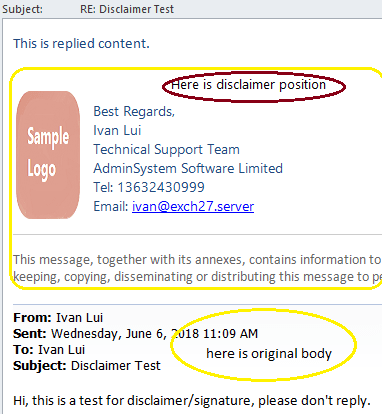
Using this option can place disclaimer/signature at better position in email body.
Multiple disclaimer rules¶
You can define multiple rules for individual user or a group.
If If current rule is applied, skip next rule is not checked in Advanced options,
all rules will be applied to the matched email based on rule priority.
For example:
# rule 1
If Sender address matches the following pattern, add disclaimer/signature
*@exch27.server
# add personal signature for users in domain level.
#rule 2
If Sender address matches the following pattern, add disclaimer/signature
*
# add a global Confidentiality Notice
Then the disclaimer/signature for a domain user is like this:
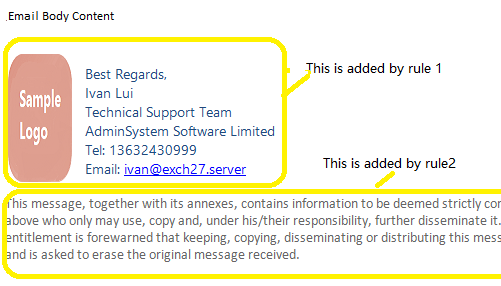
Header Conditions and Exchange Server Transport Rule¶
If you would create more complex conditions that "Disclaimer Manager" doesn’t support,
you can combine Exchange built-in Transport Rule and Header Condition like this:
Open Exchange Admin Center (https://yourserver/ecp) -> mail flow -> rules
Note
In Exchange 2007/2010, you should use Exchange Management Console ->
Organization Configuration -> Hub Transport -> Transport Rules to
create a new Transport Rule.
- Click plus sign and create a new rule;
- Click
"more options"; - Click
"add conditions", add the conditions you want; - In this rule, “subject or body text includes ‘mydisclaimer’ word” is added as a test condition;
- Then click
"add action"->"Modify the message properties"->"Set the message header to this value" - Header name is set to
"X-Disclaimer-Message", value is set to"yes" - Save this transport rule.

Then create a rule in "Disclaimer Manager" like this:
- Click
Disclaimer/Signature->New, - Input any description for current rule,
- Input
*inSender Address, - Click
Add more conditions, Select"Email contains one of the following headers"; - Add
X-Disclaimer-Message: yestoHeaders List, clickOK; - Click
Edit disclaimer/signatureto open html disclaimer/signature editor, input some text, clickOK, - Finally, click
Saveto save current rule.

Combining with above Transport Rule and Header Conditions, the emails
with subject or body text including "mydisclaimer" will append above disclaimer or signature.
Disclaimer Plugin troubleshooting¶
If your email does not have disclaimer/signature added after you set correct rule,
you should use Log Level to generate debug log like this:
Full debug log¶
Disclaimer and S/MIME Manager->Journal;- Change to
Full Debug Log; - Send a test email, debug log file will be available in
Installation path\logfolder very soon.
Important
Please be reminded to change the log level back to “Only Error Log” after troubleshooting, otherwise, the log file size will be large.
If there are no log files in log folder, you can verify the Disclaimer Plugin installation.
Installation permission¶
When you install Disclaimer Plugin on Exchange Server 2007/2010/2013/2016/2019, please make sure you are using “Domain Administrator” to run the installer.
Verify Exchange Transport Agent installation¶
To verify Disclaimer Transport Agent status, you can open Exchange Management Shell and input:
Get-TransportAgent
press enter
Check if there is EA Smime Agent installed and enabled in output.
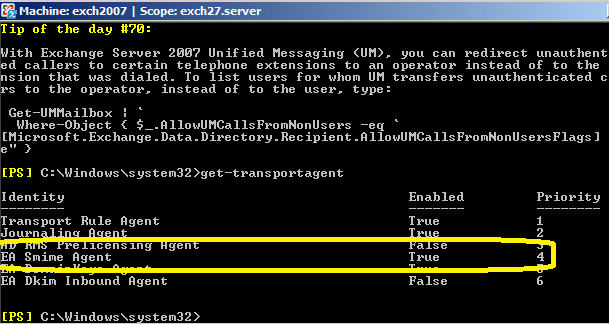
If there is no EA Smime Agent found, you can re-run installer directly
(do not uninstall) to fix this issue.
You can also contact technical support team for assistance.
Appendix: Digital signature and email encryption¶
Free Email Support¶
Not enough? Please contact our technical support team.
Remarks
We usually reply emails within 24hours. The reason for getting no response is likely that your SMTP server bounced our reply. In this case, please try to use another email address to contact us. Your Gmail, Hotmail or Office 365 email account is recommended.
